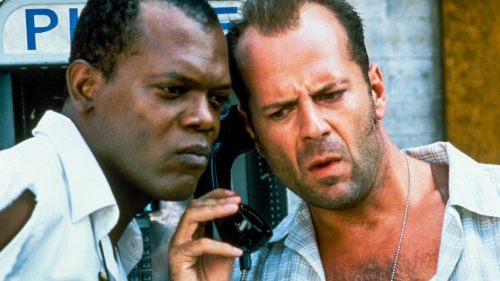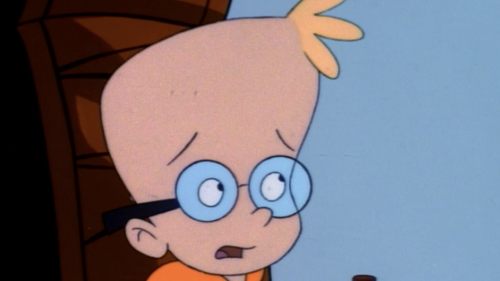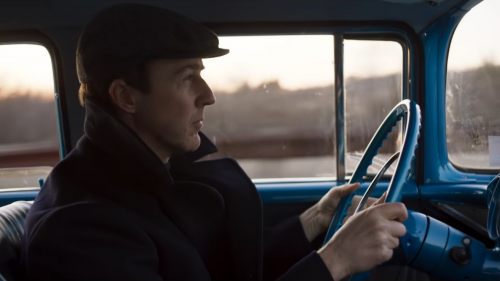Celebrating The Campy Insanity Of COLOR OF NIGHT
Head's up: heavy spoilers for Color Of Night follow.
You can point fingers all you want, but at the end of the day, I think we have Paul Verhoeven's Basic Instinct to blame for Color Of Night. When the former came along in 1992, Middle America was scandalized by the film's casual lipstick lesbianism, its willingness to blend dirty sex with graphic violence, and -- most infamously -- by its instantly-iconic Sharon Stone crotch shot. Basic Instinct was lurid and decadent in all the right ways, and the controversy it generated helped power the film to a $350m+ gross at the worldwide box office. Other films would attempt to bottle Basic Instinct's same trashy lightning in the years that followed (ahem), but few would fail as disastrously as Richard Rush's Color of Night.
Starring Bruce Willis, Jane March, Scott Bakula, and a delightful assortment of character actors definitely onboard with this kind of schlock (Brad Dourif, Lance Henriksen, Lesley Ann Warren, Ruben Blades, and Kevin J. O'Connor), Color Of Night did its best to crib from the Basic Instinct formula, but it was all for naught: people stayed away in droves, and the film earned back less than half of its $40m production budget at the box office. It went on to win a Razzie for "Worst Picture" of 1994, and spent several years as a punchline/HBO late-night mainstay before being forgotten altogether*.
And, y'know what? That's a goddamn shame, because I've just spent the afternoon revisiting Color Of Night, and I could not have enjoyed myself more. It'd been years since I'd seen the film -- and even then, I was a kid only paying attention to "the good stuff" during late-night cable viewings -- but with a fresh set of eyes and an actual attention span, I'm sort of stunned this thing isn't considered a modern camp classic. It overflows with bad performances, nonsensical asides and disastrously tacky sex scenes, but isn't that precisely why we, as a culture, have chosen to embrace Showgirls over the years**?
Please. Allow me to tell you more about Color Of Night.
The stage is set almost instantly, when -- mere moments into Color Of Night's 140-minute run-time -- what can only be described as "sexy saxophone music" begins blaring from the soundtrack. Presently, we are introduced to psychiatrist Bill Capa (Willis), midway through an appointment with a particularly troubled patient. One thing leads to another, and Bill's patient leaps from the window of his high-rise Manhattan office. A hilariously lengthy tracking shot follows her body (the most obvious "plummeting stunt dummy" gag committed to film since Mac & Me) on its trip to the pavement below, where it visibly startles a police horse. Bill, a single tear drying on his cheek, looks down from above, narrating the scene:
"It was the reddest blood I ever saw, pooled around her green dress. And then the red disappeared. Christ, Ed. It was like a vibration of color broadcast from hell. And then the red started to fade away."
Indeed, the red fades away, and we learn that Bill was so traumatized by this incident that he was struck color-blind (note: Bill's color-blindness will have zero bearing on the mystery that follows). Disgraced, despondent, and now marginally less aware of stop signs, Bill flees to California, where he hooks up with an old colleague of his, Dr. Bob Moore (Bakula), who oversees a weekly therapy group made up of various broken oddballs: the sex fiend (Warren), the artsy trust-fund weirdo (O'Connor), the prissy OCD case (Dourif), and the Lance Henriksen (Henriksen).
Oh. Yes. There's also Richie (far right), a 16-year-old dude with a stuttering problem and an explosive temper. "Richie" is a wholly unconvincing character, from his manufactured stutter to his overwrought temper tantrums to his Judd Nelson-in-The Breakfast Club costume. And from the moment he appears onscreen, it's painfully obvious that we're looking at actress Jane March, not an actual 16-year-old boy. Part of Color Of Night's big "twist" revolves around the reveal that Richie is actually Rose, the mysterious young woman (also played by March) who spends the majority of the film banging Willis' Dr. Bill. But because the disguise is never even remotely convincing, we spend most of the run-time wondering when the rest of the characters are going to catch on. It's ridiculous.
While we're waiting for that reveal to occur, Color Of Night serves up a classic whodunit tale: Dr. Bob is brutally killed in his office one night, and Dr. Bill takes over his therapy group to determine which of Dr. Bob's basket-case patients might be responsible for the murder. Along the way, he's seduced by Rose and enjoys a number of unconvincing sex scenes with her all over the late Dr. Bill's palatial estate. When you hear it like that, Color Of Night sounds like fairly standard Skinemax fare, the sort of thing Shannon Tweed might have headlined back around the time the film was made.
And if that were the case, Color Of Night would be plenty deserving of the "long since forgotten" status it's achieved in the years since its release. But as it happens, Rush's film is packed with nonsensical tangents and utterly inexplicable details that, for my money, make the film an absolute gem: the shadow-shrouded assailant who kills Dr. Bob uses not a gun or a kitchen knife, but a chain mail glove with a blade affixed to the underside, Assassin's Creed-style. In the midst of the ensuing murder investigation, Dr. Bill takes over Dr. Bob's therapy group and home without anyone ever blinking an eye, as though that's something that happens. One sex scene begins in a pool before moving into a bedroom, at which point the action stops so that Rose can present an elaborate dinner to Dr. Bill -- completely in the nude -- only for the sex scene to immediately resume inside a glass shower. Later, a rattlesnake will appear in a mailbox, and Dr. Bill will yell at it ("I'm not going back to New York, do ya hear me?!"). Later still, a toy tank crawls up March's naked body in a bathtub for no particular reason.
As insane as all of this is, it's got nothing on the film's third act. The plot builds to a final reveal that is so over-the-top ridiculous in its "twistiness" that I'm at a complete loss as to how to get the details across. Whoever edited the Wikipedia entry for Color Of Night does a pretty good job of it, though, so I'll defer to them on this one:
This leads to a twist ending: "Richie" is really Rose, and the murders have been committed by her deranged brother Dale (Andrew Lowery). They once had an actual brother named Richie who was molested by a child psychiatrist named Niedelmeyer. Richie committed suicide and, unable to cope with the loss, Dale forced Rose to play the part of their brother. Dale — who was also one of Niedelmeyer's victims — began abusing Rose until she actually became "Richie". When "Richie" was arrested for drug possession, "he" was forced into therapy. Rose soon started to re-emerge and, under another personality, "Bonnie", started relationships with other members of the group. Dale proceeded to kill them, fearing that they would soon link Rose to "Richie".
WHAT.
That paragraph really conveys the absurdity of Color Of Night: nonsensical twist is piled on top of nonsensical twist until the whole thing just implodes under its own weight***. I guess you could consider all of this ambitious and/or daring, but that's not how it feels when you're actually watching it. Instead, it feels like director Richard Rush -- along with screenwriters Billy Ray and Matthew Chapman -- learned all the wrong lessons while watching Basic Instinct. Paul Verhoeven had a Sharon Stone upskirt shot? Well, we'll get superstar Bruce Willis to hang dong. Basic Instinct's central mystery involved the villain dressing as another character? Our red herring doesn't just dress as another character: she presents herself as another gender, and has a multiple personality disorder, to boot. Basic Instinct had graphic sex scenes? Dude, one of ours will take place across multiple locations and will be so lengthy that the characters involved will have to pause for a meal in the middle of it.
It's baffling that anyone involved thought they were making something sexy or transgressive here. But I cannot tell a lie: for as bad as Color Of Night is, I am profoundly happy to be reunited with it after all these years. It is a failure as a mystery, as a piece of eroticism, as a thriller -- by almost every conceivable measure, it fails to work. You won't be invested in the mystery or care about any of the characters (indeed, you might root against the majority of them), but if you're anything like me, you'll find Color Of Night's campy weirdness and ill-advised flourishes impossible to look away from. In the end, it can't hold a candle to Basic Instinct's perfectly-balanced trashiness, but it does offer a hilarious variation on that film's formula. And if Basic Instinct's huge box office returns inspired the batshit insanity of Color Of Night, I can't wait to see what sort of terrible ideas Hollywood gets in the wake of Fifty Shades of Grey's success.
* = Until 2000, when Maxim magazine singled the film out as having the "Best Sex Scene of All-Time", a bit of trivia which shouldn't surprise anyone.
** = Note: We, as a culture, have chosen to embrace Showgirls over the years.
*** = Five years after Color Of Night, John McNaughton would attempt something similar with Wild Things, and with far greater results; whereas my love for Color Of Night is mostly ironic, my love for Wild Things is pure and true.



